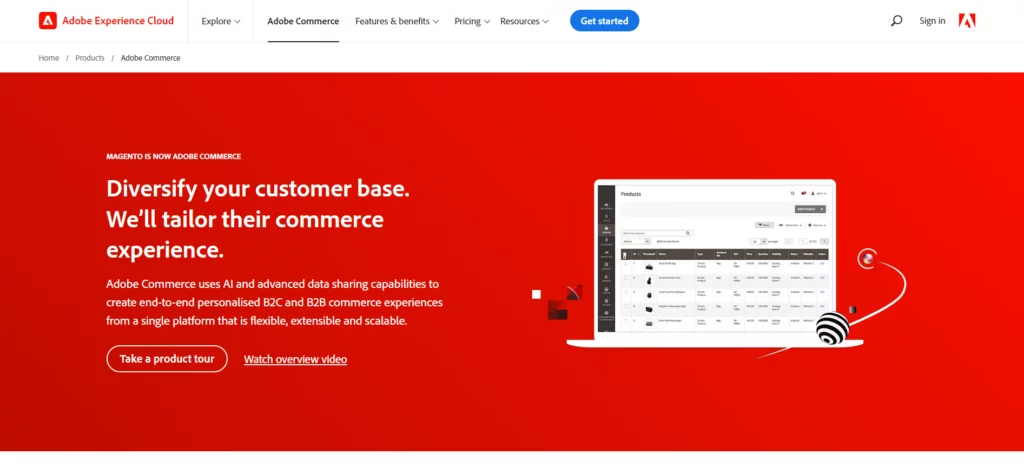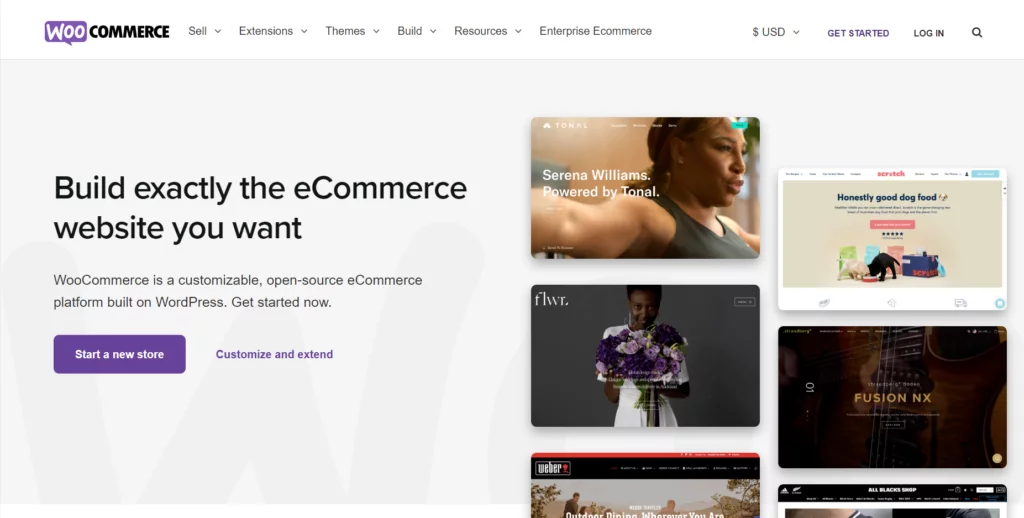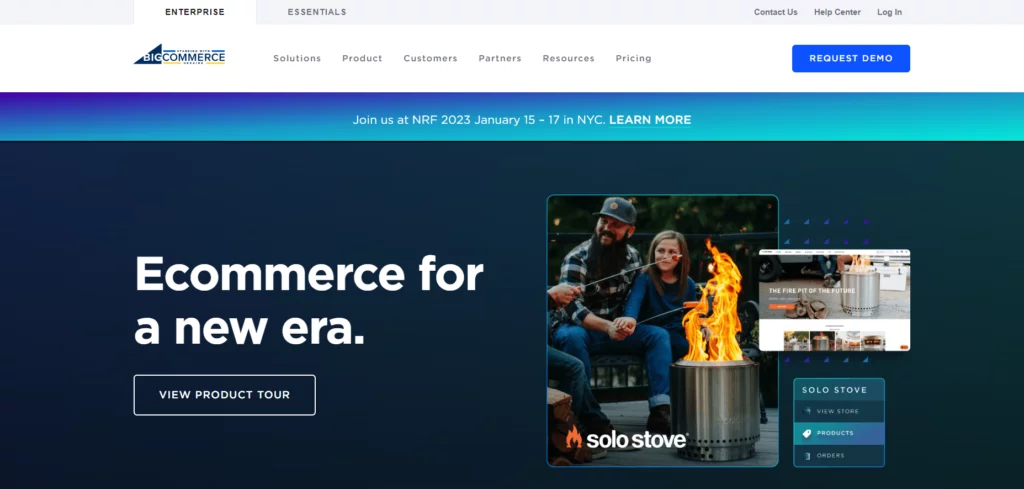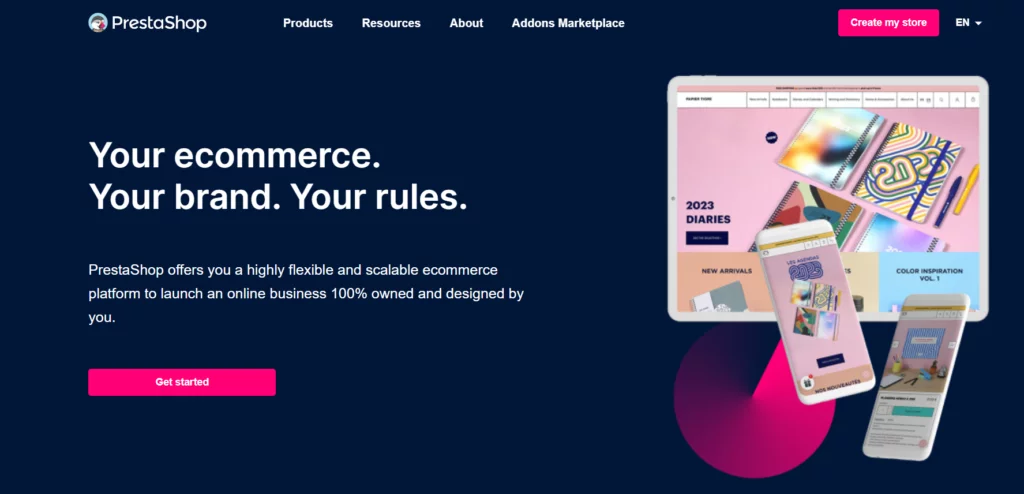- Dropshipping is a fulfillment strategy in which store owners must keep their inventory or store products. Instead, after clients make a purchase, they depend on a third-party supplier to complete the order. Without your assistance, the supplier will package and deliver the product to clients.
Due to its inexpensive startup costs and simplicity, this business model has attracted many would-be entrepreneurs in recent years. While dropshipping has several drawbacks, like low-profit margins and intense competition, this business model is nonetheless alluring to freelancers and full-timers looking to start a side hustle.
Key Dropshipping Features to look for when choosing the right ecommerce platform

-
Pricing
Typically, dropshipping businesses have minimal profit margins. When selecting the platform, make sure your ROIs are taken into consideration. While some platforms are cost-free, some have high fees.
For instance, Woocommerce makes it free to start a dropshipping platform. Additionally, it allows you to select your hosting providers, plug-ins, etc. You now have possibilities for unparalleled personalization and scalability.
-
Offer real-time shipping rates
Some ecommerce websites wait until the customer reaches the checkout page before adding shipping costs to their total. These costs could be much higher than anticipated, leading to a wagon being abandoned.
Dropshipping retailers must specifically provide real-time delivery costs. The different products in your inventory could originate from numerous suppliers and merchants spread out geographically from your customers. Your rates must reflect this; it is best practice to be open and honest about them.
This dropshipping feature may automatically calculate and display the shipping costs as the order is generated. Increasing consumer trust and lowering cart abandonment are the goals of this strategy. On the other hand, dropshipping websites may also employ per-type pricing or flat-rate delivery.
By providing a range of shipping and delivery options, you can upsell. Additionally, some clients might choose to transport a variety of things to several destinations—perhaps they are shopping for a festival. Let customers ship specific items to different locations is a great option.
-
Create a simple checkout process
Customers like dropshipping websites with straightforward checkout procedures since they can quickly complete their transactions once their orders have been fulfilled.
You may employ a dropping feature like a guest check-out option on the website. Your “excessive expectations” will prevent customers from converting. The case study of ASOS provides a great example. ASOS could lower its abandonment rates simply by removing any reference to creating an account. They desire quick transactions that are also anonymous.
The best ecommerce platform for the most configurable site builder is Shopify. BSS Commerce offers Shopify website building & customization services if you want to stand out from the competition with a more specific and tailored procedure. BSS offers each customer a customized solution for quickly and easily building a Shopify website from scratch, thanks to its certified developers.
-
Control inventory
When you employ the dropshipping business model, you hand over control of several ecommerce process elements to another organization. This includes the stock on your website, which consists of items made, kept, and shipped by other people. There are, of course, a lot of benefits to this. However, you’ll need a way to keep track of what you have to offer.
Inventory management software aims to support customers when supplies run out by providing a variety of ways to update your pages, keep track of your product numbers, etc.
-
Integrating your online store
Business with inventory management software is now easier than ever thanks to BSS Commerce’s 3rd-party integration service. Boost the efficiency of your online store’s operations using this dropshipping feature.
- Deal with chargebacks promptly
You might only have a few days to respond when you receive a chargeback, so move quickly! You must provide proof of the initial order, delivery tracking information, and—most likely—a wholesale packing slip listing the items you ordered and sent to be eligible for a refund.
Sadly, you will lose if the chargeback is for an order with different billing and shipping addresses. Payment processors typically reimburse only fraudulent orders delivered to the card’s billing address.
-
Exemplary customer service
Above all, whether you use a template service or buy development tools like Shopify, be sure the service provider offers top-notch customer support. You must be able to get in touch with customer service and get assistance quickly away if you experience any issues with your dropshipping store.
The professionalism of your business might be damaged by downtime or malfunctions in your storefront, so you should have the best technical support ready to assist you in resolving any problems that may arise.
-
Include security in the development of your website
To execute a transaction, you will ask your customers for specific and sensitive personal information, such as a dropshipping website. Therefore, enabling SSL in your website design to protect sensitive personal customer information would be desirable.
Additionally, it’s important for SEO because Google declared in 2014 that HTTPS is a ranking indicator. Using this dropshipping feature technique will stop unauthorized individuals from accessing client information.
This is what people are looking to buy websites online to search for. You can use the security feature of your website to encourage visitors to your online store. You must secure your website to satisfy PCI standards if you plan to take credit card payments.
Dropshipping might be a fun direction for your business. Create your online store on an ecommerce platform that provides a wide range of possibilities for that business model if you want to make the most of the experience.
-
Scalability
As your company expands, you may draw tens of thousands or millions of visitors. It isn’t very pleasant when you are prepared for expansion, but your preferred platform doesn’t comply. As your Business expands, your platform should assist you in scaling.
-
Easy of use
Both the front end and the back end of your online store must be managed by you as the store owner. This is very important when choosing a platform. For instance, since Woocommerce is just a WordPress plugin, managing your Woocommerce store is simple. Therefore, WooCommerce is simple to use if you’re utilizing WordPress.
Additionally, Shopify includes a clean, simple-to-use back panel that simplifies managing an online store. Be sure to take dropshipping features like usability into account while choosing your ecommerce platform.
-
Marketing Tools
The store’s creation is only one aspect of the equation; the final piece is marketing it to the intended audience. The platform you use should offer marketing and SEO dropshipping features to aid your ranking on search engines and exposure to your target markets.
For instance, you can use Yoast, All in One SEO Pack, Google XML sitemaps, etc., with WordPress Woocommerce to raise the ranking of your store. Shopify allows you to add SEO Suite, SEO Optimizer, SEO Booster, and other products that can improve your search engine ranking.
-
Integrations for dropshipping
You should be able to connect with top-notch suppliers who provide dropshipping services using a solid platform. Dropshipping plugins like Spocket, Woodropship, AliDropship, etc., are simple to connect with Woocommerce. Before choosing your ecommerce platform for dropshipping, review the integrations for dropshipping.
-
Integrated marketing tools
Marketing tools and SEO dropshipping features are crucial to draw new customers and promote your dropship brands. If the platform doesn’t offer the crucial tools you require, you could need to spend more money on add-ons and apps.
How to Start a Dropshipping Company

- Identify goods to sell
Find your niche first. Finding your dropshipping niche is a topic of much discussion online, but this is just a trendy term for asking whether or not your goods will find a market.
Try thinking of fervent fan bases or audiences with a shared need or interest as a strategy to find your niche (dog lovers, anime fans, parents who love to dress up their kids in matching outfits, sailors, very tall people, people who love 90s throwback tees). These populations are eager to spend money on goods they find appealing.
- Don’t market anything risky or protected by copyright
Start with something that doesn’t go in or on a person’s body if you’re learning. Do you have coverage for such liability if something goes wrong and you need clarification on the ingredients’ quality and source? Additionally, you can run into difficulty if the item features a famous person or a character from a popular film series.
- Examine the feedback left by the seller and order a sample
How long has the merchant been in Business? What kind of responses are they receiving?Does a test product live up to your expectations when you order it? What should you tell your consumers to ensure they are pleased with the goods when they receive them?
- Think about dropshipping a select few things
You don’t have to dropship everything because you’re dropshipping some items. For huge, bulky, expensive specialty commodities, dropshipping might make sense.
Imagine that you have a website where you sell nautical goods. You might wish to keep some products and transport yourself, but dropship the anchors. Due to the size and seriousness of the purchase, your clients may also be more understanding of extended shipping dates for items like these.
In the same way, you could dropship couches while keeping modest items in hand for home products. This is a really simple technique to broadening your inventory.
- Visit a supplier directly and establish a dropshipping partnership with them
This is a brilliant strategy because there will undoubtedly be less competition. In essence, you’re establishing a new market for a product that needs to be seen by consumers who are ready to make a purchase. Every other subscriber uses the same database if you use it.
- Nail the basics
You should spend money on a quality domain name, and it’s an essential part of every e-commerce enterprise. You can then set up your website once it is done. If you choose Shopify, you may start using it right away. Many dropshippers suggest the Shopify Brooklyn theme, which has a nice font selection. There is still another e-commerce choice available. If you’re interested in learning more, check out our review of the top ecommerce systems.
With 99Designs, you can create a professional logo for your website at a fair price without any design experience. For additional information, including how to hold a logo design competition, see my piece on how to create your first brand identity on a budget.
Additional important components to consider when planning and setting up are as follows:
- Set up appropriate email addresses for your dropshipping Business. A logical beginning (help@, support@) with your domain name is advised.
- Send forth clear signs of trust to your customer. High-quality product images and original writing, a genuine and detailed About Us page, and the judicious application of tools like pop-ups and discounts can all help you achieve this.
- Set expectations for delivery times. Most drop shipped things will reach the client later, and in a world where Amazon Prime has established a benchmark of two days, dropshipping times of 30 days feel incredibly slow. Your customers will be angry if you don’t prepare them.
- Bundle your credit card orders to prevent your bank from canceling your numerous orders. Tell your bank what kinds of orders you’ll be placing and how many of each so they won’t be marked as fake. Reordering orders you’ve already ordered can be painful (you have a corporate credit card, right?).
- Be ready for cancellations and returns. How will you handle dissatisfied clients? What is your return policy, and how do you handle customer charges? Are you going to get the returned goods or your distributor? How does that function? It’s crucial to set everything up as though it will be a tremendous success, just like anything else in Business.
- Put money aside to pay taxes. When you reach a particular sales level and use Shopify as your payment processor, Shopify will automatically report your sales to the government. Make sure you have the funds available to pay any necessary taxes.
Set Yourself Apart With Dropshipping Features

- Making your store listings and adverts distinct is a beautiful way to stand out immediately. If you can quickly and easily put up a dropshipping order for a particular product, another store can likely do the same. You’ll need to develop a competitive advantage. Why would someone choose to buy from you over your rival?
- Ensure that people are aware of your store. This can be done using word-of-mouth marketing, social media advertisements, viral memes, influencer programs, SEO, or a newsletter. To make sales, you’ll need customers.
- Take photos of your product/service. Create a copy of your own. Make original social videos. Consider carefully the best way to explain the product and the reasons someone would want it: What issues does it address? Can it bring them joy?
- You can import user reviews if you utilize AliExpress. Being the first to purchase something is not enjoyable.
- Think about providing free shipping as well. That has the power to attract clients. Does free delivery apply to all orders or only those that meet a minimum purchase amount? What spending minimum or threshold works best?
- Utilize advertisements to collect information and test different approaches. We’re confident you’ll be purchasing advertisements. If you do, purchase the data and use it to test what is effective. What gains popularity? Increase your efforts. What fails? Discard it.
- Change your audience, advertising approach, or product line as a result. Following the early traction entails moving away from what isn’t working and toward what is.
- Take an analytical approach to your sales trends. What has good sales? What is completely not selling? Are there any recurring themes among the things? What you can, copy. Stop doing what doesn’t work.
Which Is Better: Open-Source or Hosted Ecommerce Platform?
Open-source software platforms
Choose an open-source platform if you value customization and have solid technical knowledge. These systems typically let you read and edit the source code, which opens up countless customization options for your website’s look and functionality. Users cannot exercise this amount of control on hosted platforms.
To optimize your store completely, you’ll need to learn how to code, hire an internal tech staff, or outsource. Additionally, an open-source platform only offers you formal assistance; therefore, you will need to use their online tools and ask for assistance from their communities.
Hosted Platform
In contrast, hosted systems are the best option if you want active support from government employees without having to worry about infrastructure-related duties.
Without technological expertise, you may quickly set up and manage an online store using these platforms. All you have to do to set up your store is select a plan, purchase your store domain if you still need one, and pick a pre-made theme.
If you choose a hosted platform, you won’t have to worry about selecting a hosting solution, security flaws, or version updates. Additionally, the customer care staff of these website builders will provide you with devoted and prompt assistance.
The inability to modify your store is one flaw of hosted platforms. Therefore, you will primarily need to rely on third-party programs and plugins to add more functionality to the platform’s default features.
TOP DROPSHIPPING PLATFORMS

One of the most well-known eCommerce platforms, Magento has a solid reputation for having robust built-in functionality and excellent customizability. Because of its excellent scalability, this is also one of the top eCommerce platforms for dropshipping. As you may already be aware, dropshipping businesses have the potential to develop enormously, making the need for an eCommerce platform that allows for quick scaling essential.
Magento needs basic coding knowledge to set up and customize key features because it is an open-source platform. However, its backend is rather understandable, so you can quickly become accustomed to it. Additionally, this feature-rich platform includes various strong integrated tools and integration so you can easily manage your Business.
Magento provides two alternatives:
- Magento Open Source: Downloading and installing this version are entirely free. If you don’t know anything about coding, you’ll need to pay for hosting, a domain, extensions, and a development fee.
- A more expensive version of Magento Open Source is Magento Commerce (formerly Adobe Commerce). Full-featured eCommerce solutions from Adobe Commerce are appropriate for enterprise-level enterprises.
Pricing
Magento Open Source: Free
Magento Commerce: from $22,000/year
Recommended Magento dropshipping extensions:
- Magento 2 Dropship Extension by Webkul
- Dropshipping for Magento 2 by Amasty
- Magestore Dropship Module
- Aliexpress Dropshipping by CedCommerce
Pros:
- Simple to scale up
- Logical backend user interface
- Sophisticated SEO features.
- Several integrated marketing elements.
- several extensions for dropshipping.
Cons:
- Need to be set up using coding skills
- Most dropshipping extensions only allow you to import products from AliExpress

WooCommerce is a free WordPress plugin that enables eCommerce functionality on your WordPress website and transforms it into an online store, although it is not an independent platform. Being an open-source solution, WooCommerce enables you to scale your Business while providing limitless flexibility and customizability. Additionally, it has many strong SEO tools passed down from WordPress that you may use to boost your dropship store’s marketing strategies.
Compared to other open-source platforms like Magento, WooCommerce’s dashboard is easier for store owners to set up and administer because it is built on the WordPress framework. WooCommerce is a wonderful eCommerce platform for dropshipping for newcomers looking to start a side business because it can be quickly linked with your current WordPress website.
Pricing:
WooCommerce can be downloaded and installed for free, but you’ll need to pay for hosting, a domain, themes, and extensions. WooCommerce, like Magento, doesn’t take a cut of your sales, regardless of how lucrative your Business becomes.
- Hosting: $5 – $110/month
- Theme cost: $0 – $100/ year
- Extension cost: $0 – $299
Recommended WooCommerce dropshipping plugins:
- DropshipMe, AliDropship, WooDropship for China suppliers
- Spocket and Spreadr for US & Europe suppliers
Pros:
- Simple to use and begin
- For beginners, prices are reasonable
- Strong internal SEO tools inherited from the WordPress platform
- Numerous trustworthy dropshipping plugins
- Numerous forums and a sizable community to look for assistance
Cons:
- Invest time and energy into website optimization if your company grows
- Needs a lot of plugins to run smoothly
- Costly hosting

Along with Shopify, BigCommerce is another well-known SaaS eCommerce platform. BigCommerce strives to offer mid-market and enterprise-level e-commerce solutions with included top e-commerce features.
BigCommerce is a feature-rich hosted platform with extensive SEO tools, cart recovery programs, and email marketing integration to make running your Business easier. BigCommerce is one of the top eCommerce platforms for dropshipping since it is appropriate for businesses that sell hundreds to thousands of items.
Pricing:
There is no transaction fee for all plans.
- Standard: $29.95/month
- Plus: $79.95/month
- Pro: $299.95/month
- Enterprise: Contact
Recommended BigCommerce dropshipping apps:
- Printful for POD dropshipping products
- Webkul AliExpress Dropshipping App for AliExpress products
- Spocket, Modalyst, InventorySource for the US & Europe suppliers
Pros:
- Usable platform; nothing to learn
- Cost-effective pricing.
- Sophisticated SEO features
- Several marketing tools are
- Connect to a variety of trustworthy dropshipping programmes for US and UK vendors as well as AliExpress.
- Possess the capacity to expand.
Cons:
- The price will go up if you sell a certain number of units.

Wix began as a simple drag-and-drop website builder for making attractive and expert-looking websites. Wix created Wix eCommerce to allow anyone to construct their eCommerce store without any coding or design knowledge needed to keep up with the expanding eCommerce trend.
Wix ecommerce offers a hosted solution with all the eCommerce features required to launch an online store with ease, to give an easy-to-start commerce package for solopreneurs and small enterprises. To help your dropship business expand, Wix offers more than 80 ready-made templates, a user-friendly drag-and-drop interface, and numerous automated marketing options.
Wix is a wonderful dropship eCommerce platform for small firms that are eager to develop a strong and appealing brand because of the readily available and aesthetically pleasing theme designs and the different design options.
Pricing:
- Basic Business: $17 per month
- Enterprise Unlimited: $25 per month
- VIP for Business: $35 per month
Recommended dropshipping addons and extensions:
For your convenience, Wix has connected with the Modalyst marketplace, a significant suppliers marketplace. You merely need to find products, connect your store to the Modalyst marketplace, and start selling on Wix after constructing your Wix website. Fulfillment will be handled by your dropshipping suppliers, who will also ship directly to your clients.
Pros:
- Simple to set up and operate
- Drag and drop interface that is simple
- Beautiful free themes are offered
- Managing and controlling dropship products is simple
- Includes marketing automation
- Reasonable pricing ranges
Cons:
- Limited integration with dropshipping marketplaces
- SEO result are poor
- Restricted sales activities

PrestaShop is another top-notch open-source dropshipping eCommerce platform. This open-source eCommerce solution is renowned for being simple while retaining all the customization options. It provides an online demo store so you can easily explore all of its essential features and see how well-functioning your online store will be. The dashboard is quite user-friendly, and managing products and customers on a regular basis is relatively easy. Although you don’t need to be a technological specialist to launch and set up, it’s best to arm yourself with basic coding skills to make your Business operate to its full potential.
PrestaShop, a well-known open-source platform, undoubtedly offers several integrated marketing & SEO solutions to aid in maximizing the performance of your store. Starting a dropshipping business with PrestaShop takes little time because there are numerous ready-to-use beautiful theme designs you can import to your store in a single click.
Pricing:
PrestaShop may be downloaded and installed for free because it is open-source. You must still pay for hosting, extensions, and developer costs, though:
- A monthly hosting fee of $4 to $14.
- Cost of a developer: $50 to $80 per hour.
- Extension prices start at $35.
- Theme price: $50 to $699 (one-time purchase).
Recommended dropshipping addons and extensions:
You may integrate various dropshipping modules with your store from the PrestaShop modules store. You only need to manage the product catalog and select reputable dropship providers to start selling immediately.
Pros:
- Open-source technology
- Free to use and download
- No monthly charge
- Strong internal SEO tools
- Several modules for addons to improve shop performance.
Cons:
- Limited integration of suppliers
- The majority of vendors use AliExpress
- Comparatively speaking to other platforms, page load time could be more spectacular.
6. SQUARESPACE

Squarespace started out as one of the most well-liked CMS platforms before introducing Squarespace Commerce by integrating cutting-edge eCommerce functionality. This eCommerce solution was created with small businesses in mind, and it offers a variety of attractive starting themes as well as an advanced website builder.
Since Squarespace is a software as a service (SaaS) platform, it covers all of your hosting and domain costs. All you have to do is sign up, choose one of their elegantly crafted templates, and begin quickly personalizing your store.
To assist you in managing your company for the best business growth, Squarespace also provides a variety of SEO services, marketing tools, and site statistics.
Dropshipping addons and extensions:
Seven third-party fulfilment services can presently connect with your online store using Squarespace. While some provide POD dropshipping & warehousing, some of them assist you in locating and importing profitable products from the dropshipping industry. Future updates to the supplier list will also be made.
Pricing:
Private: $12 per month
Company: $18 per month
$26/month for basic commerce; $40/month for advanced commerce
Pros:
- Reasonable price structures
- Various attractive and qualified website templates are available for use
- Simple to set up
- No extra charges
Cons:
- There are limited dropshipping suppliers
- Few payment gateways
- Lack of selling points
FAQ
- Why is dropshipping a smart move?
One of the most practical ways to start an online business is through dropshipping because you don’t have to worry about managing product inventory, fulfillment, and shipping. Furthermore, you can access a huge selection of reliable vendors for dropshipping goods in China, the US, and Europe. Because there are no order minimums with the dropshipping strategy, you can upload many products and test the market.
- Which ecommerce platform works the best for dropshipping?
You can establish a dropshipping business using either an open-source platform or a hosted platform, both of which are types of eCommerce platforms. Open-source platforms are unquestionably your best option if you have solid coding skills and value freedom and customization. Meanwhile, a hosted platform manages all technical responsibilities on your behalf so you can focus on running your Business.
- Does dropshipping yield a profit?
Unlike other company models, dropshipping is quick to start and doesn’t require a lot of capital, however, this might also result in low-profit margins. Due to the fierce competition in the market, you will have to reduce your profits to maintain competitive sales pricing.
- What advantages does dropshipping offer?
The following are some advantages of the dropshipping business model:
- Because there is no need for physical inventory, less capital is needed.
- Extremely simple to begin without having to bother about running a warehouse, sending out orders, managing returns, etc.
- With no product inventory or storage expenditures, enjoy cheap overhead.
- You can begin from any location on the planet. With Shopify, online business owners can make money from home.
- a huge product collection. Thanks to dropshipping providers, providing a wide range of distinctive products to your potential clients is simple.
- Which goods are available for drop shipping?
You may dropship a wide variety of goods, including silicone kitchen staples, fashion and clothes, electronics, home decor, hand sanitizers, masks, and exercise equipment. On apps like Oberlo, you can look for the goods you want to sell. Depending on your location, suppliers may occasionally offer goods in additional categories of consumables and perishables.
- Are there any don’ts when it comes to dropshipping features?
Follow these dropshipping recommendations if you want your Business to run smoothly:
- Don’t concentrate on your specialized market and stay away from selling what everyone else does.
- Don’t just rely on price to differentiate yourself from the competition.
- Don’t forget to prominently advertise your brand.
- Avoid developing convoluted return and refund policies.
- Expecting to become wealthy through dropshipping overnight is unrealistic.



